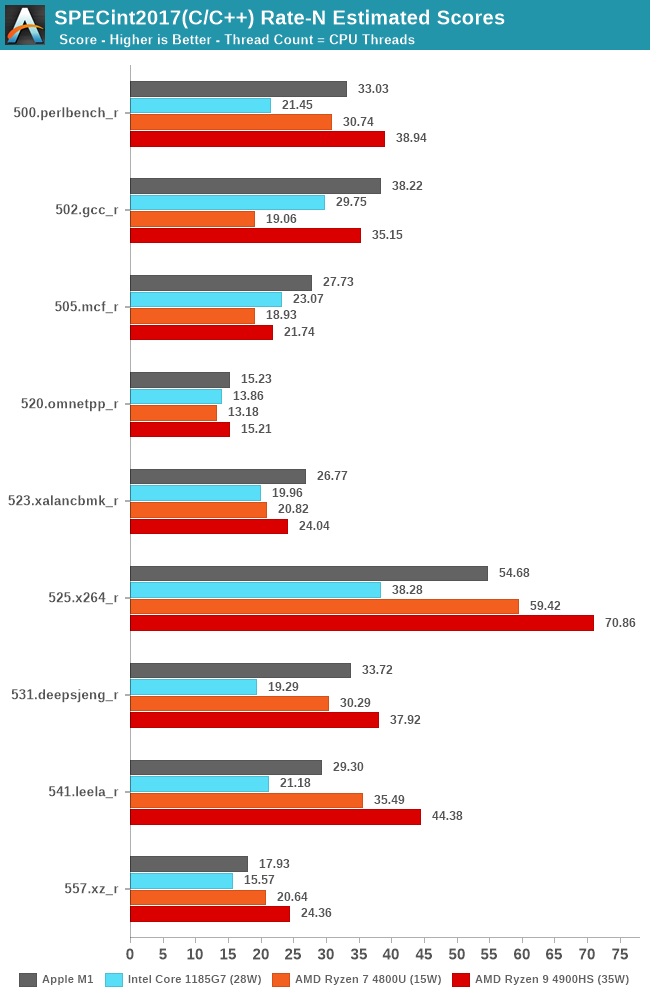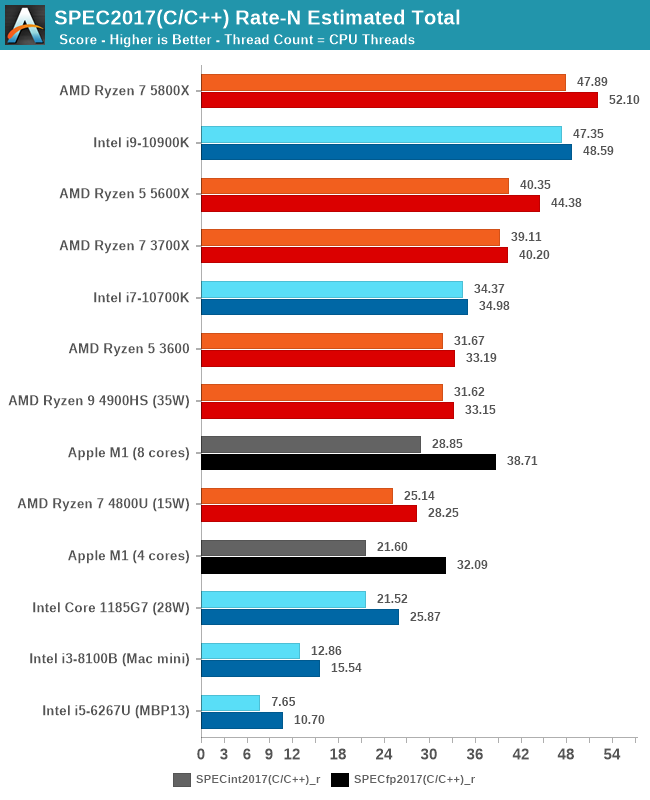The 2020 Mac Mini Unleashed: Putting Apple Silicon M1 To The Test
by Andrei Frumusanu on November 17, 2020 9:00 AM ESTSPEC2017 - Multi-Core Performance
While we knew that the Apple M1 would do extremely well in single-threaded performance, the design’s strengths are also in its power-efficiency which should directly translate to exceptionally good multi-threaded performance in power limited designs. We noted that although Apple doesn’t really publish any TDP figure, we estimate that the M1 here in the Mac mini behaves like a 20-24W TDP chip.
We’re including Intel’s newest Tiger Lake system with an i7-1185G7 at 28W, an AMD Ryzen 7 4800U at 15W, and a Ryzen 9 4900HS at 35W as comparison points. It’s to be noted that the actual power consumption of these devices should exceed that of their advertised TDPs, as it doesn’t account for DRAM or VRMs.

In SPECint2017 rate, the Apple M1 battles with AMD’s chipsets, with the results differing depending on the workload, sometimes winning, sometimes losing.

In the fp2017 rate results, we see similar results, with the Apple M1 battling it out with AMD’s higher-end laptop chip, able to beat the lower TDP part and clearly stay ahead of Intel’s design.

In the overall multi-core scores, the Apple M1 is extremely impressive. On integer workloads, it still seems that AMD’s more recent Renoir-based designs beat the M1 in performance, but only in the integer workloads and at a notably higher TDP and power consumption.
Apple’s lead against Intel’s Tiger Lake SoC at 28W here is indisputable, and shows the reason as to why Apple chose to abandon their long-term silicon partner of 15 years. The M1 not only beats the best Intel has to offer in this market-segment, but does so at less power.
I also included multi-threaded scores of the M1 when ignoring the 4 efficiency cores of the system. Here although it’s an “8-core” design, the heterogeneous nature of the CPUs means that performance is lop-sided towards the big cores. That doesn’t mean that the efficiency cores are absolutely weak: Using them still increases total throughput by 20-33%, depending on the workload, favouring compute-heavy tasks.
Overall, Apple doesn’t just deliver a viable silicon alternative to AMD and Intel, but actually something that’s well outperforms them both in absolute performance as well as power efficiency. Naturally, in higher power-level, higher-core count systems, the M1 can’t keep up to AMD and Intel designs, but that’s something Apple likely will want to address with subsequent designs in that category over the next 2 years.










682 Comments
View All Comments
BushLin - Tuesday, November 17, 2020 - link
Meanwhile in reality, 7nm zen 2 is trading results with impressive initial offering by Apple. 7nm zen 3 is available in desktop and 5nm zen 4 becomes available when Apple's exclusively at TSMC ends.Spunjji - Thursday, November 19, 2020 - link
5nm Zen 4 will be contemporaneous with the second generation of M1 on N5P.SarahKerrigan - Tuesday, November 17, 2020 - link
The microarchitecture is Apple, not ARM; this is a fully-custom core.RogerShepherd - Tuesday, November 17, 2020 - link
Architecture is ARMs; microarchitecture is Apple's. And you can speculate about Apple's influence on the ARM V8 architecture.BlackHat - Tuesday, November 17, 2020 - link
Yeah, even the 4500U ryzen, is 27 slower in single core than this chip, with 18 power draw, a zen 3 version with other 19% IPC improvement should be very competitive.BushLin - Wednesday, November 18, 2020 - link
...and that's before we focus on doing some real work in multithreaded tasks.KoolAidMan1 - Tuesday, November 17, 2020 - link
Qualcomm's implementation is a joke. Their performance has been 18 months behind Apple's for the better part of a decade. It isn't as simple as saying "this is an ARM processor" while disregarding that Apple's chip design is so far ahead of everyone else in that space.Intel has been trying to poach their head of chip development (who prior to working at Apple was one of their higher ups) to be their new CEO for over a year now. Apple poached the best around 2008 and this is the payoff.
Nick B - Tuesday, November 17, 2020 - link
Apple has a perpetual ARM licence because they co-founded ARM. Apple does NOT use ARM reference designs, just the licence.haghands - Tuesday, November 17, 2020 - link
The ISA is arm but the microarchitecture is entirely Apple. They've been designing their own cores from scratch since 2012.andreltrn - Tuesday, November 17, 2020 - link
The microarchitecture is nor ARM. The microarchitecture is from Apple and they use the ARM instruct ruction set. Apple was the first to design and produce a 64 bit ARM processor. They did that a year before ARM came out with their 64 bit design.